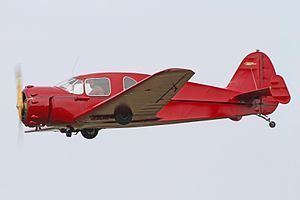Manufacturer AviaBellanca Aircraft | ||
 | ||
The Bellanca 14-7 and its successors were a family of light aircraft manufactured in the United States shortly before World War II.
Contents
Design and development
Bellanca had already established itself in the market for aircraft in the 6–8 seat size, but believed that it could also successfully sell smaller (3–4 seats) aircraft. The first example flew in 1937. The 14-7 was a modern, low-wing cantilever monoplane with a fuselage intended to contribute lift to the design. Although the prototype flew with fixed tailwheel undercarriage, the 14-9 production version was the first US light aircraft to be mass-produced with retractable undercarriage; the main wheels rotated aft, up into wells in the wings.
Operational history
Development culminated in the 1941 14-12, at which point production ceased to allow Bellanca to work as a military subcontractor for the duration of the war when an attempt to market a militarized version as a trainer was unsuccessful. After the war, Bellanca returned to the design to create the Bellanca 14-13 and its successors.
Variants
14-9L - Fitted with a Lenape Brave engine.
Specifications (14-9)
Data from Flying Equipment: Bellanca 14-9
General characteristics
Performance
